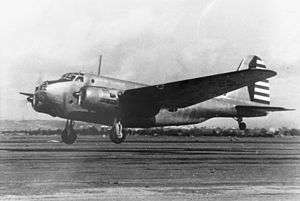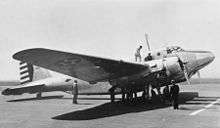North American XB-21
| XB-21 | |
|---|---|
 | |
| Role | Medium bomber |
| National origin | United States |
| Manufacturer | North American Aviation |
| First flight | 22 December 1936 |
| Primary user | United States Army Air Corps |
| Number built | 1 |
| Unit cost | |
The North American XB-21, also known by the manufacturer's model designation NA-21, and sometimes referred to by the name "Dragon",[2] was a prototype bomber aircraft developed by North American Aviation in the late 1930s, for evaluation by the United States Army Air Corps. Evaluated against the Douglas B-18 Bolo, it was found to be considerably more expensive than the rival aircraft, and despite the ordering of a small number of evaluation aircraft, only the prototype was ever built.
Design and development
North American Aviation's first twin-engined military aircraft,[3] the NA-21 prototype was constructed at North American's factory in Inglewood, California,[4] where work on the aircraft began in early 1936.[5] The NA-21 was a mid-wing monoplane of all-metal construction, powered by two Pratt & Whitney R-2180-A Twin Hornet radial engines,[5] which were fitted with turbosuperchargers for increased high-altitude performance.[4]
Flown by a crew of six to eight men,[1] the XB-21 featured a remarkably strong defensive armament for the time,[4] including as many as five .30-calibre M1919 machine guns.[1] These were planned to be fitted in hydraulically powered[6] nose and dorsal turrets, in addition to manually operated weapons installed in waist and ventral positions.[4] Up to 10,000 pounds (4,500 kg) of bombs could be carried in an internal bomb bay, with 2,200 pounds (1,000 kg) of bombs being able to be carried over a range of 1,900 miles (3,100 km).[4]
Testing and evaluation
Undertaking its maiden flight on 22 December 1936 at Mines Field, company test flying indicated a number of minor problems.[7] Modifications resolving these resulted in the aircraft being re-designated NA-39, and, accepted by the U.S. Army Air Corps as the XB-21. The aircraft, which had been assigned the serial number 38-485,[1] was evaluated early the following year in competition against a similar design by Douglas Aircraft, an improved version of the company's successful B-18 Bolo.[1]
During the course of the fly-off, the gun turrets proved troublesome, their drive motors proving to be underpowered, and issues with wind blast through the gun slots were also encountered.[6] As a result of these problems, the XB-21's nose turret was faired over, while the dorsal turret was removed.[1]
The XB-21 proved to have superior performance over its competitor,[7] but price became the primary factor distinguishing the Bolo and the XB-21.[5] On this account, the modified B-18 was declared the winner of the competition, Douglas quoting a price per aircraft of $64,000 USD, while North American's estimate was $122,000 USD per aircraft,[1] and an order was placed for 177 of the Douglas aircraft, to be designated B-18A.[5]
Despite this, the Army Air Corps found the performance of the XB-21 to have been favorable enough to order five pre-production aircraft, to be designated YB-21.[1] However, soon after this contract was awarded, it was cancelled, and none of the YB-21s were ever built, leaving the XB-21 as the sole example of the type ever constructed.[1] Operated by North American Aviation, the XB-21 served as a research aircraft until its retirement.[3]
Although the XB-21 failed to win a production contract, it was the first of a long line of North American Aviation medium bomber aircraft, and provided experience and knowledge that assisted in the development of the North American NA-40,[8] which, developed into the B-25 Mitchell, would become one of the Army's standard medium bombers of World War II.[9]
Specifications (XB-21)

General characteristics
- Crew: Six to eight
- Length: 61 ft 9 in (18.82 m)
- Wingspan: 95 ft 0 in (28.96 m)
- Height: 14 ft 9 in (4.50 m)
- Wing area: 1,120 sq ft (104 m2)
- Empty weight: 19,082 lb (8,655 kg)
- Gross weight: 27,253 lb (12,362 kg)
- Max takeoff weight: 40,000 lb (18,144 kg)
- Powerplant: 2 × Pratt & Whitney R-2180-A Twin Hornet turbosupercharged radial engines, 1,200 hp (890 kW) each
- Propellers: 3-bladed
Performance
- Maximum speed: 220 mph (354 km/h; 191 kn) at 10,000 feet (3,000 m)
- Cruise speed: 190 mph (165 kn; 306 km/h)
- Range: 1,960 mi (1,703 nmi; 3,154 km) with 2,200 pounds (1,000 kg) of bombs
- Combat range: 600 mi (521 nmi; 966 km) with 10,000 pounds (4,500 kg) of bombs
- Service ceiling: 25,000 ft (7,620 m)
- Time to altitude: 10 minutes to 10,000 feet (3,000 m)
Armament
- Guns: Five .30-calibre machine guns, mounted in single turrets in the nose and dorsal positions, and single manually operated mounts in the waist and ventral positions.
- Bombs: Up to 10,000 pounds (4,500 kg) in an internal bay.
See also
- Aircraft of comparable role, configuration and era
- Related lists
References
Notes
- 1 2 3 4 5 6 7 8 9 10 "Factsheets: North American XB-21." National Museum of the United States Air Force. Retrieved: 21 May 2010.
- ↑ Jones 1962, p. 65.
- 1 2 Yenne 2005, pp. 64–65.
- 1 2 3 4 5 Donald 1997, p. 696.
- 1 2 3 4 5 Baugher, Joe. "North American XB-21." American Military Aircraft, 1 August 1999. Retrieved: 29 July 2011.
- 1 2 Reuter 2000, p. 38.
- 1 2 Rusinek 2005
- ↑ Yenne 2006, p. 87.
- ↑ Donald 1997, p. 697.
Bibliography
- Donald, David, ed. The Complete Encyclopedia of World Aircraft. London: Orbis, 1997. ISBN 0-7607-0592-5.
- Jones, Lloyd S. U.S. Bombers, B1-B70. Fallbrook, California: Aero Publishers, 1962. ASIN B0007FFBSO.
- Reuter, Claus. Development of Aircraft Turrets in the AAF, 1917-1944. New York: S.R. Research & Publishing, 2000. ISBN 1-894643-08-9.
- Rusinek, Ed. "A Tale of Two Dragons." North American Aviation Retirees Bulletin, Winter 2005.
- Yenne, Bill. The American Aircraft Factory in World War II. St. Paul, Minnesota: Zenith Press, 2006. ISBN 0-7603-2300-3.
- Yenne, Bill. The Story of the Boeing Company. St. Paul, Minnesota: Zenith Press, 2005. ISBN 0-7603-2333-X.
External links
| Wikimedia Commons has media related to North American XB-21. |